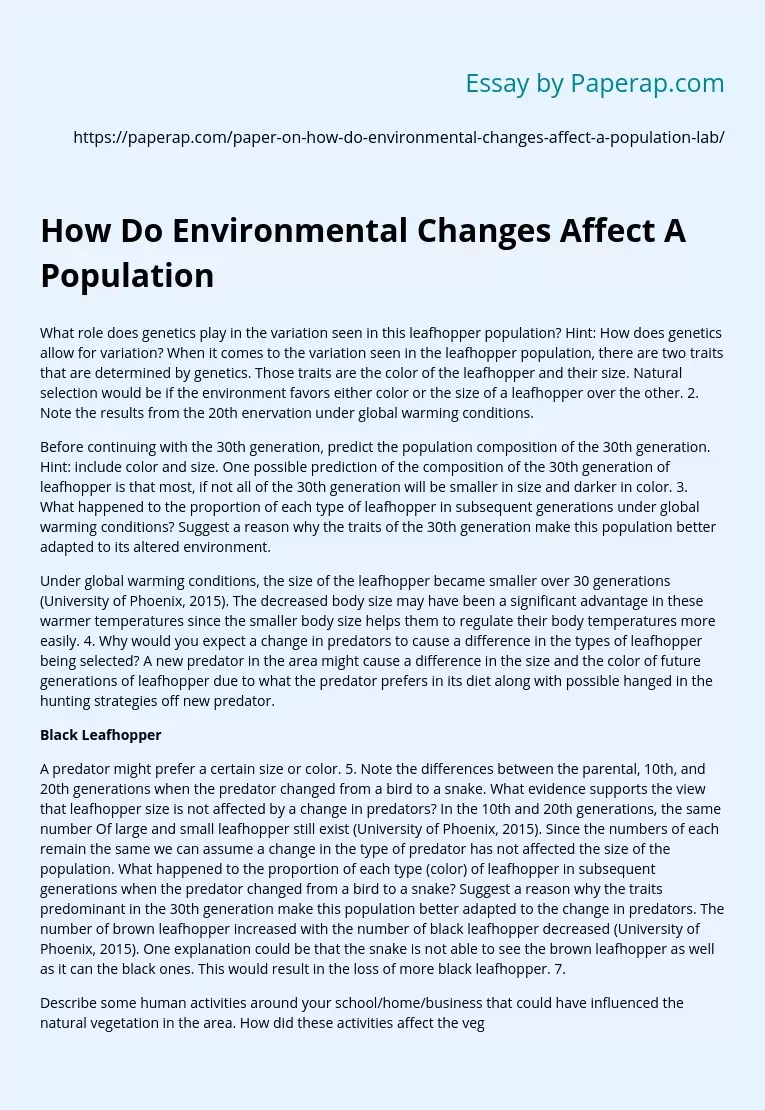How Do Environmental Changes Affect A Population
What role does genetics play in the variation seen in this leafhopper population? Hint: How does genetics allow for variation? When it comes to the variation seen in the leafhopper population, there are two traits that are determined by genetics. Those traits are the color of the leafhopper and their size. Natural selection would be if the environment favors either color or the size of a leafhopper over the other. 2. Note the results from the 20th enervation under global warming conditions.
Before continuing with the 30th generation, predict the population composition of the 30th generation. Hint: include color and size. One possible prediction of the composition of the 30th generation of leafhopper is that most, if not all of the 30th generation will be smaller in size and darker in color. 3. What happened to the proportion of each type of leafhopper in subsequent generations under global warming conditions? Suggest a reason why the traits of the 30th generation make this population better adapted to its altered environment.
Under global warming conditions, the size of the leafhopper became smaller over 30 generations (University of Phoenix, 2015). The decreased body size may have been a significant advantage in these warmer temperatures since the smaller body size helps them to regulate their body temperatures more easily. 4. Why would you expect a change in predators to cause a difference in the types of leafhopper being selected? A new predator in the area might cause a difference in the size and the color of future generations of leafhopper due to what the predator prefers in its diet along with possible hanged in the hunting strategies off new predator.
Black Leafhopper
A predator might prefer a certain size or color. 5. Note the differences between the parental, 10th, and 20th generations when the predator changed from a bird to a snake. What evidence supports the view that leafhopper size is not affected by a change in predators? In the 10th and 20th generations, the same number Of large and small leafhopper still exist (University of Phoenix, 2015). Since the numbers of each remain the same we can assume a change in the type of predator has not affected the size of the population. What happened to the proportion of each type (color) of leafhopper in subsequent generations when the predator changed from a bird to a snake? Suggest a reason why the traits predominant in the 30th generation make this population better adapted to the change in predators. The number of brown leafhopper increased with the number of black leafhopper decreased (University of Phoenix, 2015). One explanation could be that the snake is not able to see the brown leafhopper as well as it can the black ones. This would result in the loss of more black leafhopper. 7.
Describe some human activities around your school/home/business that could have influenced the natural vegetation in the area. How did these activities affect the vegetation? There is a lot of open land where I live. Over the years I have noticed some of this land being cleared and leveled to make way for new homes and businesses. This not only affects the vegetation that grows in this area, but the wildlife, as well. 8. Notice the differences between the parental and the 30th generations. What happened to the proportion of each type of leafhopper when the vegetation hanged?
Suggest a reason why the traits Of the 30th generation make this population better adapted to its altered environment. When the vegetation changes, so does the size and color of the 30th generation of leafhopper. Over the generations the population adapted by changing their body size to medium. The leafhopper are thriving with the change in vegetation due to not having to require as much for their own survival (University of Phoenix, 201 S). 9. Identify some major sources of pesticides in your area. What are the pesticides used for?
Some of the major sources of pesticides in the area where I live are the farms in the surrounding area and homeowners. The farmers spray their crops to keep unwanted bugs and rodents away from the food that they are growing and individuals spray pesticides inside and outside of their homes to keep away bugs and dangerous insects. 10. What happened to the proportions of leafhopper in each subsequent generation when pesticides were added to the environment? Explain why all the leafhopper were not killed by the pesticide application.
The average size of the leafhopper increased to the larger size while the majority changed color to mostly black (University of Phoenix, 2015). It is possible that some of the leafhopper had a gene that was passed down through the generations that was resistant to the pesticides being used.
How Do Environmental Changes Affect A Population. (2019, Dec 05). Retrieved from https://paperap.com/paper-on-how-do-environmental-changes-affect-a-population-lab/

